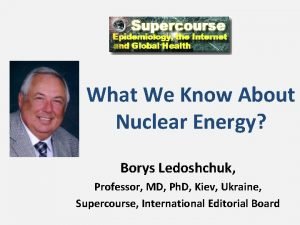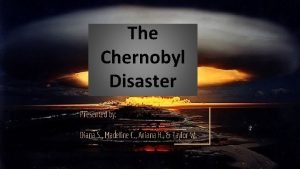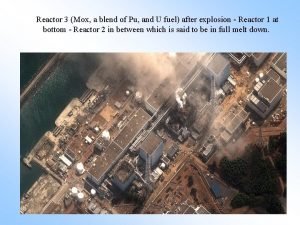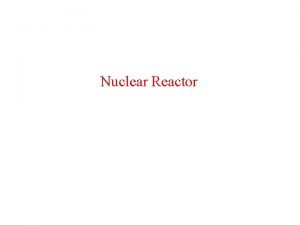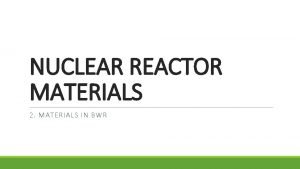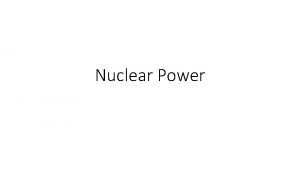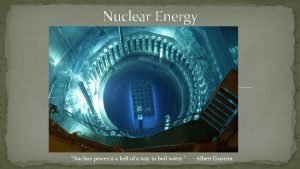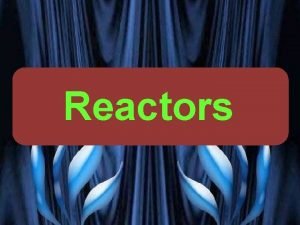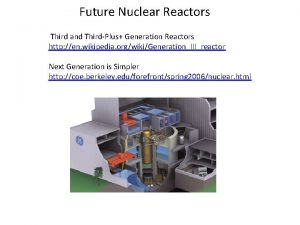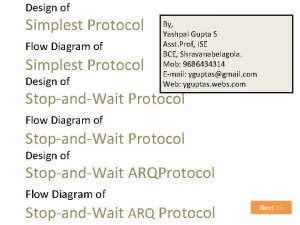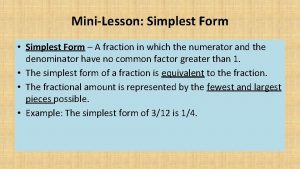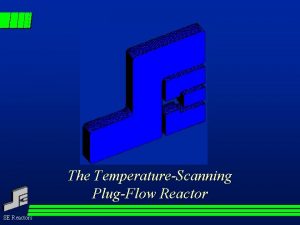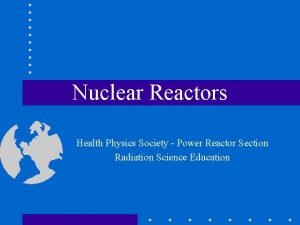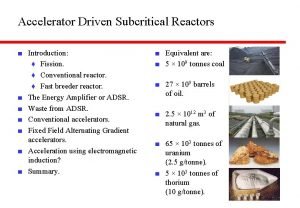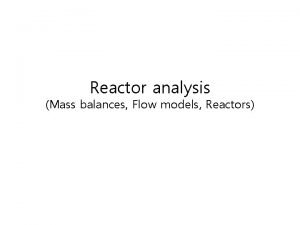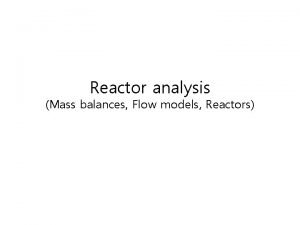TYPES OF REACTOR THERMAL REACTORS are the simplest












- Slides: 12

TYPES OF REACTOR • THERMAL REACTORS are the simplest and most proven of reactor types. Others are under development • FAST REACTORS • ‘Fast’ refers to the speed of the neutrons • Using the table of cross-sections (Lecture 17)we can evaluate h (Fuel Utilisation Factor) from sf and s. C for a reactor fuelled by 50% 235 U and 50% 238 U ( average n. AV ~ 2. 5 for both) Tn Me. V 2 0. 3 0. 001 sf (barns) s. C (barns) h= n. AV x sf / s. A . 5(. 6+1. 3) ~ 0. 9 . 5(. 2+0) ~ 0. 1 2. 3 . 5(0+1. 3) ~ 0. 6. 5(0+8) ~4 . 5(. 2+0) ~ 0. 1. 5(4+3) ~ 3. 5 Lecture 19 2. 1 1. 4 1

• Note that h > 1. 3 even for neutrons slowing below 1 Me. V – A CHAIN REACTION CAN BE MAINTAINED WITH HIGHLY ENRICHED FUEL • Prototype fast reactor at Dounray and first production model at Le Bouget NOTES • A moderator is not required for these reactors • Good heat transfer properties needed (Liquid metals e. g Na) • A NEUTRON REFLECTOR is required • Expensive to build and highly enriched fuel is also expensive (Takes power!) • Only worth considering because fast reactors can be used as the BREEDERS of new fuel – e. g. 233 U and 239 Pu Lecture 19 2

BREEDER REACTORS • Consider the capture of neutrons in 238 U which dominates the cross-section for Tn < 0. 1 Me. V g bbn + 238 U --> 239 U* -->239 U -->239 Np -->239 Pu T 1/2=23 min T 1/2=2. 3 days 239 4 235 U, is FISSILE • 94 Pu has T 1/2= 2. 4 10 yrs and, like • Also if natural thorium captures neutrons g bbn + 232 Th --> 233 Th* -->233 Th -->233 Pa -->233 U T 1/2=22 min T 1/2=27 days 233 • 92 U is also FISSILE with thermal neutrons • Hence it is possible to breed fissile material in reactors Lecture 19 3

• Some 239 Pu is produced in ALL thermal reactors containing 238 U – The 239 Pu then becomes part of the fissile fuel – the most neutron efficient reactors produce the most 239 Pu by this method • If the fuel rods are taken out of the reactor before the 235 U has been used up, the 239 Pu can be CHEMICALLY separated from the U and the fission products in a REPROCESSING PLANT. • The 239 Pu can then be used for making nuclear weapons – Hence the reason for international inspection of nuclear power plants under the auspices of the IAEA Lecture 19 4

• If the fuel rods are retained in the reactor for maximum 235 U (and 239 Pu) burn up the residual 239 Pu is contaminated by 240 Pu g n + 239 Pu --> 240 Pu* --> 240 Pu T 1/2=6540 yrs • Chemical separated Pu would not then be suitable for weapons manufacture but it could still be used again in reactors • To breed more fuel than is used up more than one neutron must be captured by 238 U for every 235 U fission THE BREEDING RATIO B • B is the number of new fissile atoms produced in a reactor per atom of existing fuel consumed by fission + neutron capture Lecture 19 5

THE BREEDER CYCLE IS : - • For a sustained reaction h = 1 + B + C + L • Typically C + L ~ 0. 2 so if B>1 then h ≥ 2. 2 • Clearly B>1 is required for net fuel production • The table in 2. 5 shows h>2. 2 for fast neutrons only • Fast reactors can be used for breeding § h can be increased if more highly enriched fuel is used (with 235 U or 239 Pu increasing average n from 2. 5 to 2. 9 say) §An improvement is also achieved by fission by fast neutrons in 238 U or 232 Th blanket Lecture 19 6

GEOMETRY OF A BREEDING REACTOR • When sufficient 239 Pu has been produced it can be extracted TIMESCALE FOR BREEDING • Consider a fast breeder with 2 tonnes of 239 Pu, 20 tonnes of 238 U, operating at 1000 MW • Consumption of Pu = mass of Pu atom x power / energy per fission Lecture 19 7

• If B = 1. 2 then we gain 0. 2 x 0. 39 ~ 0. 08 tonnes / year • This generates fuel for a second reactor (i. e. 2 tonnes) in 2 /0. 08 years = 25 years!! • Concern about the Earth’s fuel reserves interest in Breeder Reactors • UN statistics (1984 excluding Eastern Europe, USSR and China) FUEL COAL EQUIVALENT IN 109 TONNES COAL 1520 OIL 140 GAS 115 URANIUM 146 (No breeding, 2% burn up) URANIUM 7300 (Breeding, 100% burn up) • Rough numbers depending on what it is considered economic to recover Lecture 19 8

Schematic of a FAST REACTOR • Extra radiation hazards – Continuous energy distribution of n – n+23 Na 24 Mg* 24 Mg+ gg b- T 1/2 ~ 15 hours Lecture 19 9

A pool type sodium cooled fast reactor Lecture 19 10

EXAMPLE: A fast breeder reactor operates with a plutonium fuel. Plutonium emits on average 3. 0 neutrons per fission and the neutron fission and absorption cross sections are sf = 1. 8 b and s. A = 2. 15 b respectively. Determine a value for h. Assuming that the neutron losses are 20% in total calculate the value of B. The breeder reactor operates at a rating of 500 MW per tonne of fuel. Calculate the neutron flux and the consumption of plutonium fuel per year (You may assume that 200 Me. V is released per fission). Hence calculate the ‘doubling time’, i. e. the time needed to double the amount of fuel. Lecture 19 11

For plutonium So h = 3. 0 x 1. 8 /2. 15 = 2. 51 B = 2. 51 – 0. 2 = 1. 31 The reaction rate is given by R = Nsf f where N is the total number of plutonium atoms In 1 tonne of plutonium N = 1000 /( 239 x 1. 66 10 -27) = 2. 52 1027 Number of fissions per second = R = 500 x 106 /(200 x 1. 6 10 -13) = 1. 56 1019 s-1 So 1. 56 1019 = 2. 52 1027 x 1. 8 10 -28 x f f = 3. 44 1019 neutrons m-2 s-1 The rate of consumption of the original fuel is RPu= Ns. A f RPu= 2. 52 1027 x 2. 15 10 -28 x 3. 44 1019 = 1. 86 1019 atoms / s Or 1. 86 1019 x 1. 66 10 -27 x 239 = 7. 38 10 -6 kg s-1 or 233 kg / year The rate of production of excess fuel is 0. 31 x 233 kg / year so the doubling time is TD = 1000 / (0. 31 x 233) = 13. 8 years Lecture 19 12
 Low voltage three phase choke coil filter reactor in pfc
Low voltage three phase choke coil filter reactor in pfc Antigentest åre
Antigentest åre Thermal energy section 3 using thermal energy
Thermal energy section 3 using thermal energy Thermal transfer vs direct thermal printing
Thermal transfer vs direct thermal printing Fission reactor nuclearcraft
Fission reactor nuclearcraft Chernobyl disaster presentation
Chernobyl disaster presentation Reactor design pattern
Reactor design pattern Reactor pattern example
Reactor pattern example Magical reactor 3
Magical reactor 3 Which control
Which control Boiling water reactor
Boiling water reactor Nuclear reactor anatomy
Nuclear reactor anatomy Rbmk reactor design flaws
Rbmk reactor design flaws




